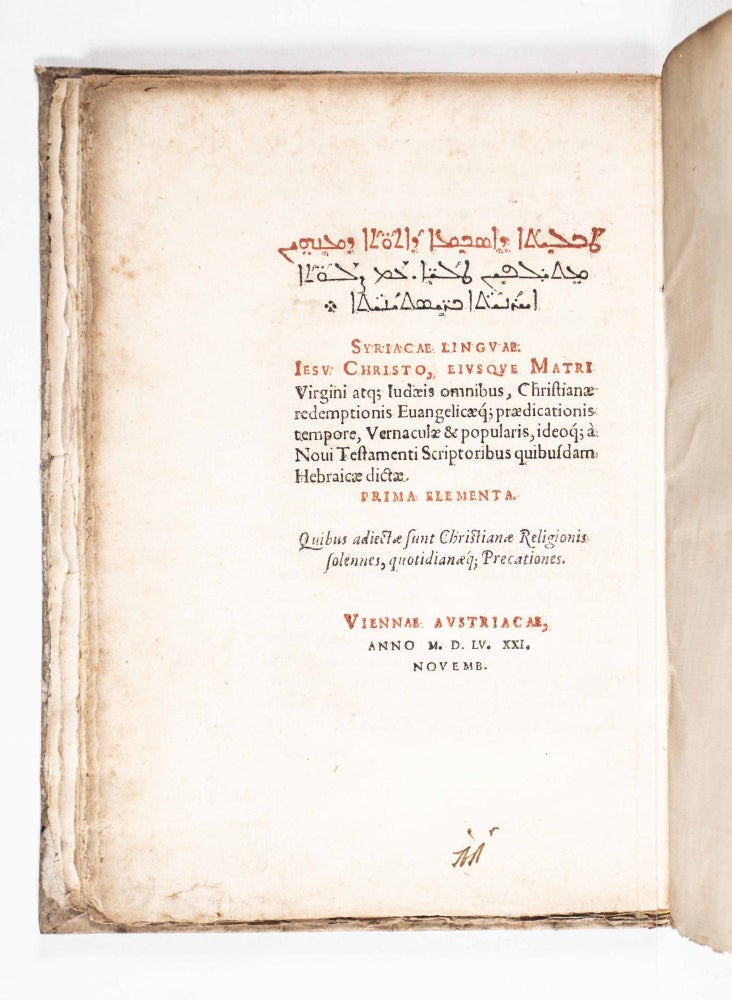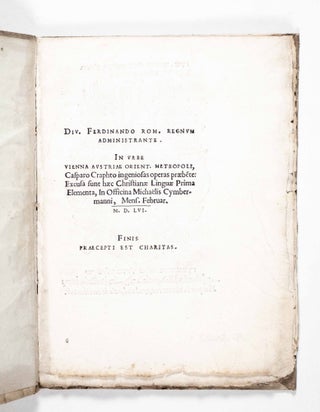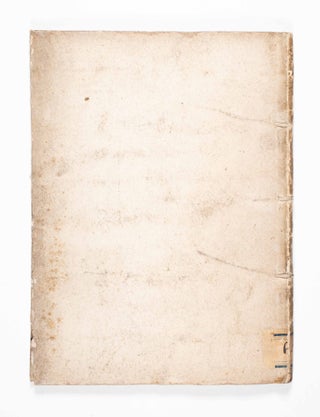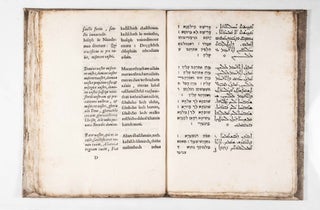Syriacae linguae (A Primer on the Syriac Language)
Vienna: Michael Zimmermann, 1555. First edition. Paperback. Small quarto: A-G4 (= 28 unnumbered leaves; text reads from right to left). Title in red and black; text in Syriac (with vocalized Hebrew and Latin transliteration) and Latin, mostly formatted in two columns per page; full page woodcut armorial device at recto of final leaf. Later light weight rustica boards, with exposed cords. Faint foxing and dust soiling about the edges, but still a fine, crisp copy, uncut and unopened.
First edition of this Syriac alphabet and syllabary (15pp.), accompanied by a selection of hymns and prayers; it is sometimes found bound with the editor's 1555 editio princeps of the Syriac New Testament. The title unambiguously notes that Syriac (an Aramaic dialect) was the common language among the Jews in the era when Jesus preached the Gospel, and for that reason was sometimes referred to as "Hebrew" by certain New Testament writers (à Novi Testamenti scriptoribus quibusdam Hebraicae dictae). The Syriacae linguae was re-edited by Guy Le Fèvre de La Boderie (Boderianus) to accompany his edition of Severus of Antioch's writings on baptism, published at Antwerp by Plantin in 1572; an enlarged reproduction of Widmannstetter's original text (but without the preface) appeared in 1971 in Werner Strothmann's Die Anfänge der syrischen Studien in Europa. This is a notably early example of Syriac printing, and an early publication of Michael Zimmermann, a native of Zurich, active in Vienna from 1553-1565, who was the first printer in that city to have a foundry. The splendid serto Syriac types are the first to be used in Germany, and were cut by Kaspar Kraft from Ellwangen. Nestle observes that the handwriting of Moses Mardenus, the Syrian priest who aided Widmannstetter in his Syriac studies, bears a striking resemblance to the types cut for the New Testament, and employed here in the present Alphabet. Smitskamp notes that the first Syriac grammar to employ Syriac types was published at Pavia in 1539 by Theseus Ambrosius (one of Widmannstetter's teachers).
The four-column format of the liturgical readings (in Syriac type; transliteration into vocalized Hebrew type; transliteration into the Latin alphabet; Latin translation), as it employs Hebrew types, is therefore among the very earliest (and rare) examples of Hebrew typography in Vienna: Pannonius' 1544 De Bello Turcis reproduces in woodcut only a few Hebrew lines from the biblical book of Proverbs; the selections from the biblical book of Jonah which appear in Planck’s 1552 Hebrew grammar occupy only eight pages; the second editon of Weidner's Loca Praecipua, which contains the author's substantial letter to the Jews, does not appear until 1562. According to Freimann, after these few examples, Hebrew typography does not resume in Vienna until 1793, with the appearance of Anton Schmidt’s edition of the Mishnah. Vinograd's listing of (substantial) Hebrew imprints in Vienna begins only in the eighteenth century.
The statesman, humanist, and celebrated Orientalist, Johann Albrecht Widmannstetter (1506-1557) was born in the village of Nellingen. The elephant which appears in his coat-of-arms (reproduced in woodcut at the conclusion of the Syriacae Linguae) was chosen in imitation of the arms of the dukes of Elfenstein, a town close to his birthplace. Widmannstetter would become one of the earliest promoters of Semitic language studies in Germany. The author of the Syriacae Linguae tells us that he owed his thorough education to Italy, however, where he came in 1527, and where he found his second home for a number of years. There Widmannstetter was initiated into the mysteries of the Hebrew language and theology by the aged Dattilus in Turin, teacher of Pico della Mirandola, and later by the Roman rabbi Michael ben Shabbethai Zematus, who both studied and taught under Cardinal Aegidius of Viterbo. He learned Arabic from the Spaniard Jakob Lopez Stunica, along with north African Muslims living in Italy, and was introduced to the Qur'an by Benjamin Arignanus while in Rome. He was tutored in Syriac by a Syrian monk, Theseus Ambrosius, and later by Simeon, bishop of the Syrians of Mount Lebanon. These studies proved fruitful: with financing from Holy Roman Emperor King Ferdinand I, and a manuscript brought from the Near East by the Mesopotamian priest, Moses of Meredin, Widmannstetter edited in 1555 the New Testament in Syriac, the first substantial Semitic language publication to appear in Vienna. Fine. Item #48866
References: Adams W-138. ADB 42, pp. 357-361: "zählt zu den frühesten Pflegern der orientalischen Studien in Deutschland, das Syrische ward hier geradezu durch ihn begröndet". Darlow & Moule M-8948. Freimann, Gazetteer of Hebrew Printing (NYPL, 1946). Mayer, Wien 1:71. Nestle (Syriaca) 3; Zur Geschichte der syrischen Typen 57 (pp.16-17). Moss 1142. Smitskamp, PO, 92 (cf. 91 for Widmannstetter’s Syriac NT). VD16 W-2490. Strothmann 16. Zenker 2:1525. For Zimmermann (active 1553-1565) see: Benzing, Beiträge, 455.7
Full title and imprint: Syriacae linguae. Iesu Christo, eisque Matri Virginis atque Iudaeis omnibus, Christianae redemptionis evangeliaeque pradicationis tempore, vernaculae [et] popularis, ideoque à Novi Testamenti scriptoribus quibusdam Hebraicae dictae. Prima elementa. Quibus adiectae sunt christianae religionis solemnes, quotidianque precationes. Viennae Austricae, M.D.LV. XXI. Novemb. [21 November 1555] [Colophon: In Officina Michaelis Cymbermanni, Mens. Februar. M.D.LVI. [February 1556].
Price: $4,750.00




